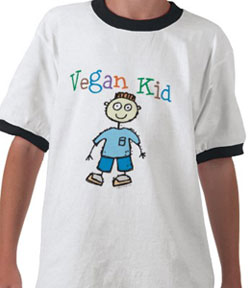Supporting the Vegan Diet Choice for Kids
by Audrey M. Smith
My eight-year-old daughter came home from school one afternoon upset and confused to what happened that day in the cafeteria. Teachers had rummaged through the lunch she brought from home and questioned her about its vegan contents. If she didn’t eat meat, what was this stuff on her sandwich? How could she stand to drink soymilk? What about nutrition? My first reaction was anger. Questions like these should have been taken up with me, not my child. Calming down, I decided to talk to some family and friends in various professional fields, including education.
The conversations catapulted me back 25 years to when I became a vegan. The shocking revelation about my diet always led to the same comments and disgusted grimaces, “How can you eat that junk?” When I mentioned my vegan children, things got downright nasty. Accusations about poor nutrition flew and some conversations even ended with people walking off in a huff.
The Facts
- No matter the diet choice, most people get most of their nutrients from grains, vegetables, and fruits. Common dishes such as pasta primavera and peanut butter and jelly sandwiches are vegan, while many traditional dishes and family favorites are readily converted.
- The American Medical Association (AMA), American Dietetic Association (ADA), and Physicians Committee for Responsible Medicine (PCRM) support vegan diets for children and adolescents as healthy alternatives to the traditional meat-based American diet.1, 2, 3, 4, 5, 6
- From the ADA: “Well-planned vegan and other types of vegetarian diets are appropriate for all stages of the life cycle, including during pregnancy, lactation, infancy, childhood, and adolescence. Vegetarian diets offer a number of nutritional benefits, including lower levels of saturated fat, cholesterol, and animal protein as well as higher levels of carbohydrates, fiber, magnesium, potassium, folate, and antioxidants such as vitamins C and E and phytochemicals.” 7
- Although leading medical experts agree that vegan diets are especially healthy for children and teens, family doctors are not well-educated about it and tend to supply patients with out-dated, incorrect data. 5
- Myth: Vegan protein sources are incomplete. Current research shows the body combines amino acids to form complete proteins. Eating a variety of plant based proteins daily, like soy products, legumes, vegetables, and grains ?such as beans, soy products, grains, and vegetables supplies quality, usable protein with less fat and no cholesterol than animal-based proteins. 7, 8
- Starting children on a healthy diet early in life, influences their future health, weight, and need for medical treatment. The numbers speak for themselves:
- Vegetarians have lower blood pressure. Hypertension is reduced by one-third to one- half that of non-vegetarians.
- Vegetarians have much lower cholesterol levels. In fact, one study showed a 25% reduction in cholesterol after only 12 months on a vegan diet.
- Cancer rates are an astounding 25-50% lower, depending on the type of cancer.
- Vegetarians live 7 to 15 years longer.
- The abundance of phytochemicals found in fruits, vegetables, herbs, nuts, grains, and seeds not only protect plants from damage, but contain powerful protective substances for people. The pigments that give plants brilliant color protect our health and in many ways such as preventing heart disease, cancer, cataracts, high blood pressure and cholesterol, strengthens our body systems, and may even slow aging.
Sidebar 1 Did You Know…
- “2%” milk is really 35% fat. It’s 2 percent fat only by weight; 35 percent of the calories are derived from fat. Whole milk is 49% fat. 4
- 75 percent of the world’s population is lactose intolerant. 4
- The United States is the only country that still uses bovine growth hormones. The European Union banned them.
- Protein should be 10-15% of our daily calories, yet Americans typically eat far more 4
- Iron-deficiency anemia is the most common nutritional deficiency in children, regardless of diet. There are an abundance of plant sources to meet iron needs: dried beans, dark green leafy vegetables, fortified breakfast cereals, raisins, prune juice, spinach, figs, pumpkin seeds, broccoli, blackstrap molasses, whole grains, and nuts. To aid iron absorption, combine these foods with foods rich in vitamin C, such as orange juice, broccoli, or tomatoes. 1, 3, 4, 5, 6
- In recipes calling for 1-2 eggs, you can often leave them out and instead add a few extra teaspoons of water to make up for the moisture the eggs would have added.
- Only animal-derived “food” products contain cholesterol.


